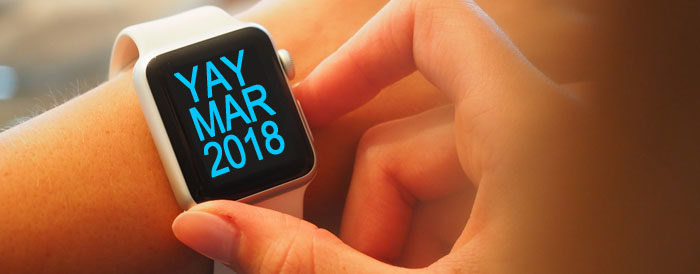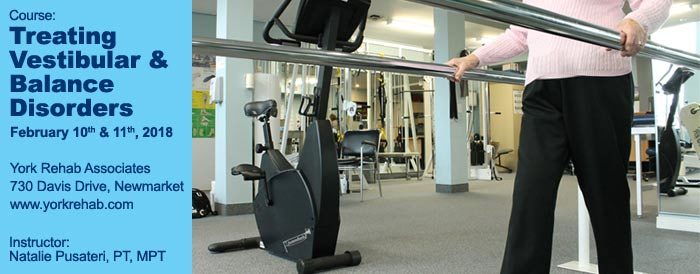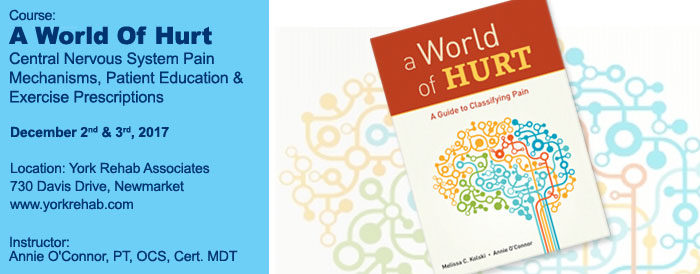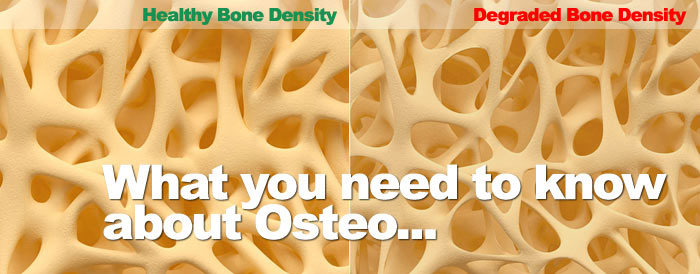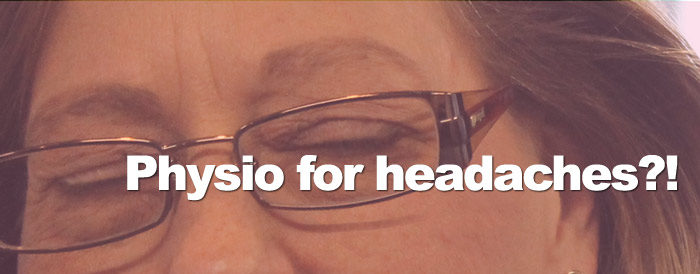March…The Perfect Time for Resolutions
Most would not argue with the statement that 80-90% of people who start a New Year’s resolution at the beginning of January are probably not going to make it to February. Most resolutions are meant to improve people’s lives and make them happier, so it’s sad that so many people give up on their dreams so prematurely. There are varying reasons that can explain the failure to keep resolutions but some of the more common ones are connected to setting too many goals at once, making your goals too general or making them too big. Whether you’ve consciously or unconsciously abandoned your resolutions after only a few weeks of trying, the good news is you don’t have to wait until next January to make another attempt. March is the perfect time to pick yourself up, dust off and give it another go. Here are a few things that can help you make your second shot at your desired life change more permanent.
First, Look at the Data
If you’ve failed at keeping up your January resolutions, you’ve now accumulated useful data. Between when you started and when you quit, you can likely pull some information that can show you what worked with your attempt and what didn’t. Taking a closer can help you to figure out what things you can do differently so that you don’t repeat failure a second time. For example, maybe your resolution was to start exercising regularly (5 days a week), but you were only able to exercise 3 evenings the first week, then 1 evening each of the next two weeks. That data would show evening exercise didn’t fit well with your schedule. So on a second attempt at the resolution, exercising first thing in the morning would be a better plan.
Figure out what’s REALLY Important to You
People sometimes decide on resolutions for superficial reasons and a deeper look can uncover that a particular resolution may not really matter to you. You might have a resolution to stop eating chocolate – but upon closer inspection you discover that what you really want to do is start eating healthier as a whole. Deciding to focus on only eliminating chocolate from your diet wouldn’t yield you the type of results you want because you could simply replace one less than ideal food choice with another.
Be Specific with Your Goal Setting
Break down your goal into specific parts so you know exactly what you need to do, and when you plan to do it. The wrong way to approach a resolution like incorporating more exercise into your routine would be to say “I’m going to exercise more this year”. When you’re that vague, it allows you the flexibility to interpret “…exercise more…” any way you want – i.e. I exercised twice this month, hopefully I’ll exercise more next month. It may not unfold exactly that way but you get the gist. Instead, be specific on how you are going to integrate exercise into your routine, i.e. I’m going to do yoga four times a week on Mon, Wed, Fri and Sat first thing in the morning. By listing specific steps, you’ll know when you’re not keeping up and that you might need to address something in order to stay on track with your goal. Choose the SMART method for goal setting:
Specific
Measurable
Achievable
Relevant
Time-based
Don’t Do Too Much at Once
There’s an endless list of things one would want to change about themselves but trying to make many changes at once is usually difficult. Start with one goal and once you have built some momentum with maintaining it, only then should you consider working on another goal at the same time.
Create Accountability for Yourself
Don’t keep your goals hidden, share what you want to accomplish with someone close to you. You’ll be more committed when you know someone is watching. And invite them to inquire about your progress. When you know someone is going to check up on you, it’s added incentive for you to keep up with your efforts so you have results to communicate when you’re asked: “How are things going?”
Measure and Celebrate
Keep track of your progress, whether by journaling or marking progress on a calendar. A visual record of your progress helps you maintain momentum because it allows you to see how much you’ve already done. And identify milestones so that you can have mini celebrations along the way. If you need to lose 20lbs, it’s much better to celebrate each time you lose 5 than waiting to celebrate only after you’ve lost the full 20.
And Finally, Lighten Up!
Making a change is not easy, especially if it’s a significant change. There will be moments of discomfort and times when you just won’t do what you are supposed to do. If you have a moment of weakness and stumble, don’t use that as an excuse to quit – no one is perfect, failure along the way is normal. Also, accept that your goal won’t always be exciting and fun to tackle and that you may often not want to complete your task(s). Most of the time you probably won’t feel like doing what you should be doing – recognize that motivation won’t always accompany you. Despite the absence of motivation, do what you need to do anyway. Focus on developing the simple habits that will get you going, i.e. if you need to get in a morning run – just focus on getting your shoes on, and once those laces are tied what follows will be automatic.
Treating Vestibular & Balance Disorders (Course: Feb 10-11)
Treating Vestibular & Balance Disorders (2-Day Course)
Dates: February 10th and 11th, 2018
Location: York Rehab Associates, 730 Davis Drive, Newmarket, ON. L3Y 2R4
Course Purpose: To familiarize clinicians with vestibular and non-vestibular causes of imbalance and dizziness and to learn how to assess and treat these dysfunctions. This course is appropriate for (but not limited to) any physiotherapist/assistant treating MSK (trauma, orthopedic…), ABI geriatrics, SCI, Stroke, Long Term Care.
Instructor: Natalie Pusateri, MPT has been a physiotherapist for more than 15 years and has a national certification in treating vestibular disorders. She has dedicated her career to treating those with dizziness and imbalance as well as the neurologically impaired community, sitting on several boards and obtaining additional specialties in the areas of Parkinson’s, amputees, and MS.
In addition to patient care, Natalie has devoted time to educating both the public and her peers. She has spent the last decade speaking everywhere from senior groups to the American Physical Therapy Association on the topics vestibular disorders and balance as well as preventing falls in the elderly.
She also traveled the United States providing a 2 day course on treating balance and vestibular disorders. With her move from St. Louis in 2010, Natalie brought her passion for serving this need in the population to Toronto. She is now working at both University of Toronto and Toronto Rehabilitation. She continues to give courses on treating balance and vestibular disorders throughout the GTA.
Course Fee: $350+HST= $395.50 (includes lunch)
Payable by cheque to York Rehab / Call for phone payment: (905) 715 7201
Fax Registration form to: (905) 715 7037
Cancellation Policy: Until Jan. 10th, 2018 – full refund less $25 administration fee.
Course: World of Hurt (Dec 2 & 3, 2017)
Course:
A World Of Hurt: Central Nervous System Pain Mechanisms, Patient Education & Exercise Prescriptions. Course outline is available here.
– LIVE patient demos will be included
Who should attend:
This course will benefit any healthcare provider working with patients dominated by Central Nervous System (CNS) Pain Mechanisms. Strategies to sub-group patients within this classification will be provided to allow for targeted treatment
Instructor:
Annie O’Connor, PT, OCS, Cert. MDT
Rehabilitation Institute of Chicago
Biography included within attached course outline.
When: Dec 2nd – 3rd, 2017
Time: Day #1 = 8:00 am – 5:30 pm / Day #2 = 8:00 am – 4:45 pm
Location:
York Rehab Associates
730 Davis Drive (Unit #1), Newmarket, ON, L3Y 2R4
Cost: Early bird rates apply!
$550.00 (up to and including Oct/31st/17)
$600.00 (up to and including Nov/17th/17)
– Inclusive of course instruction, manual, textbook and meals
– Textbook: A World Of Hurt: A Guide To Classifying Pain
Payment Methods:
– Cash / cheque* / debit / VISA / MasterCard
* Please make cheques payable to ‘York Rehab’
– AMEX not accepted
Registration Deadline: Nov 17th 2017
Course Coordinator:
Name: Fiona MacKenzie PT, Dip. MDT
Tel: 905-715-7201
Email: fmackenzie@yorkrehab.com
Osteoporosis – What You Need to Know
Osteoporosis is a health condition that affects bones, leading to bone thinning and loss of density, ultimately affecting their structural integrity and leading to increased fracture risk. It can occur at any age, although is more common as age increases; 1 in 4 women and 1 in 8 men over the age of 50 are affected by it. It is often called the “silent thief” because it can be present without any active symptoms. Its presence can be confirmed definitively only by a Bone Mineral Density test, which is a special type of X-ray.
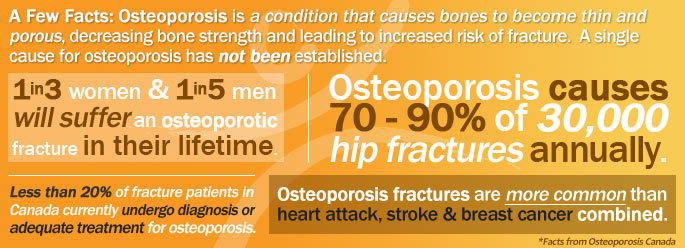
No single cause of osteoporosis has been identified. As we develop and grow through childhood and adolescence, we continue to build and “bank” bone until the age of 30. The more that we build bone during this critical period, the greater defence we have against the development of osteoporosis later in life. Bone “likes” to be exposed to regular, varying stresses to adapt and grow stronger; for example, playing soccer, which involves varying amounts of jogging, sprinting, jumping, and kicking, is an example of good stress. This means that everyone should be active from a young age and continue to remain active as they grow older to minimize the risk of osteoporosis, amongst many other health conditions – unfortunately this seems to be far from the norm.
The group at greatest risk of developing osteoporosis is post-menopausal women over the age of 50. While both men and women begin to naturally lose bone starting in their mid-30s, women lose bone at a much greater rate as they approach menopause – about 2-5% per year. This risk is even greater if they are physically inactive. This is because bone is a very active tissue with lots of turnover, the misconception is that we tend to think of it as a fixed structure. There are specialized bone cells that deconstruct it, mainly to access stored calcium for numerous bodily functions, and other specialized cells that reconstruct it as it adapts to the loads that we put on it. If we don’t put enough stress through it by moving and exercising, the reconstructing cells are insufficiently stimulated and there is a gradual loss of bone.
As mentioned above, the risk for fracture is much higher when osteoporosis is present. Areas that are most common to fracture are the spine and hip. Usually we would think that a significant trauma such as a hard fall or a car accident would be necessary to cause a fracture, but in osteoporosis much lesser forces are needed; even repetitive bending can be enough to cause a spinal fracture. Compounding this problem is that because people with osteoporosis are often less active, they do not have the same balance and strength as active people, and so are more prone to falls.
What can be done to counteract osteoporosis, or prevent it from happening in the first place? While medical interventions such as supplementary calcium and Vitamin D are important to ensure bones have the nutrients they need to remain strong, one important way to help manage your disease is through exercise. Just like muscle, bone adapts to the loads applied to it and become stronger. Our Newmarket Physiotherapy clinic has a specialized exercise program called Osteo-Circuit for those with osteoporosis or low bone density. You will be assessed by a physiotherapist to determine your suitability for the program and what your customized exercise plan should be. Inquire about the next 6 week program offered at our Newmarket Physiotherapy Clinic. Here’s to better and stronger bone health – you can do it!
Physiotherapy to Fix Your Headache
Headaches are a common ailment experienced by many people. Headaches are known to have a number of causes, and the treatments are as varied as the headache symptoms themselves. Many of us accept headaches as unavoidable and are often treated with over-the-counter or prescribed medications. For some people, headaches can be quite debilitating and also resistant to traditional therapies. One possible therapeutic option that is less well-known to the general public is physiotherapy. Headaches that are “mechanical” in nature – emanating from the joints or muscles around the head and neck often affected by movement or positioning – can often be effectively treated with physiotherapy.
Mechanical headaches can come in several forms. The first type of a mechanical headache is a secondary consequence of neck problems. People who have neck pain, stiffness, or loss of movement may have accompanying headaches but may not associate their pain with a neck problem. If the headache symptoms began around the same time as the neck symptoms did, there is a good chance it is mechanical and therefore treatable with physiotherapy. When the neck symptoms are addressed by adopting exercise and postural strategies that your physiotherapist can show you, the headaches tend to fade away. Or, as neck movement improves with physiotherapy treatment, a noticeable reduction in headache intensity is experienced at the same time.
The second category of a mechanical headache is one where there is no or very little neck pain or stiffness, with the head pain being the primary symptom. If this kind of headache varies with seated positioning, such as worsening with prolonged slouched sitting at a desk and improves with more upright posturing, then the pain source is likely mechanical. And there’s an increased likelihood the headache will respond to physiotherapy treatment.
Often, people mistakenly attribute headache symptoms to “stress”. In reality, someone in a stressful situation is less likely to pay attention to their posture and positioning, which can ultimately lead to a headache. Most of the time with these types of headaches there is a key position or movement that if performed repetitively, or held as a stretch can give rapid relief. The responsiveness to treatment varies from person to person.
This is not to suggest that all headaches are mechanical. There are many headaches that will not respond to physiotherapy treatment. If your headache is constant and doesn’t vary with positioning or movement, it is less likely to be mechanical. Determining whether positioning and/or specific movements are the root cause is something a well-trained physiotherapist can help you with. Two or three appointments would usually be a sufficient amount of time for a therapist to determine whether your pain is mechanical. If you decide to see a physiotherapist for your headache and it’s determined that the pain is not mechanical in nature, you will be referred back to your doctor.
If you have a persistent headache that is not responding to medication, put down that pill bottle and pick up the phone to make an appointment with a physiotherapist. A visit to a registered physio will get you a comprehensive assessment to see if your headache has mechanical features – a McKenzie trained physiotherapist can help with this. If the cause it mechanical, they will be able to show you how to self-manage it and what to do to prevent it from coming back which can be a wonderful option that excludes the need for pills. It is surprising how rapidly this approach can work, even with headaches that have previously persisted for months or years. Explore your options; a physiotherapist may be able to offer you quick relief allowing you to return to living your life – hopefully, full of activity.

